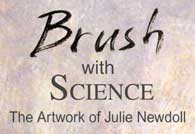

 View Portfolio |
 Inside Time |
 Shows |
 About/Contact the Artist |
Life Science Paintings:
These paintings are a reflection upon our lives from a microscopic perspective, and on microscopic images from a life perspective.
Pheromone Puppet, 4' x 5', 1994. Available for purchase.
Humans have an area just above their nose called the vomeronasal pit, which may contain pheromone receptors. This receptor would detect airborne chemicals emitted by other people. Other mammals contain such receptors, but it is a matter of debate whether humans have an active vomeronasal organ. The artist feels certain that there is, but we shall see. Such chemicals, or pheromones, are responsible for such phenomenon as women menstruating at the same time, or an unexplained "chemical attraction" for another person. The spirals in the painting show the possible protein structure of the pheromone receptor. It is very likely that there are seven helices which form this structure. Many senses have this seven helix structure. As the actual structure for the pheromone receptor has not yet been determined, a bacterial protein which captures light was used as a model. It also has seven helices, is a receptor, and related to our sense of sight.
Inspired in part by the papers "Vomeronasal epithelial cells of the adult human express neuron-specific molecules", Takami S, Getchell ML, Chen Y, Monti-Bloch L, Berliner DL, Stensaas LJ, Getchell TV., NeuroReport 4, 375-378, 1993, and also "The Human Skin: Fragrances and Pheromones", Berliner DL, Jennings-White C, Lavker RM. , J. Steroid biochem. Molec. Biol., Vol. 39, No. 4B, pp. 671-679, 1991.
Atlantis, 30" x 40", 1993.
Robin in a Sperm Surface Dress: 4' x 5', 1994. Available for purchase. $9,500 unframed.
The patterns in the window and on the dress are from electron microscope images of the surface of a sperm.
Electron Microscope Images supplied by Dr. Dan Friend, Harvard Medical School, Pathology Department.
Spermbrella for Black Days: 4' x 5', 1994. Available for purchase.
The sickle-like shape is taken from an electron microscope image of a guinea pig sperm.
Microscope image supplied by Dr. Dan Friend, Harvard Medical School, Pathology Department
Lilith in a Colicin Crystal: 3' x 4', 1996, private collection
A protein crystal structure composed of Lilith figures. Her arms, hair, and serpent tail form a relationship like that of the Colicin IA molecule when it is crystallized. Colicin is a long protein harbored by bacteria. A single molecule of it can be directed at a neighboring bacteria and kill it with a kind of punture wound. Lilith has similar potency.
Consultation for painting science with Robert M. Stroud. Paper: "Crystal structure of colicin Ia.", Wiener M; Freymann D; Ghosh P; Stroud RM , Nature 1997 Jan 30; 385(6615):461-4
Microantiquity: 30" x 38", 1993, private collection
Beginning with an electron microscope image of pits on the surface of a cell, this painting evolved.
Microscope image supplied by Dr. Dan Friend.
Copyright © 2007, Julie Newdoll. All rights reserved.